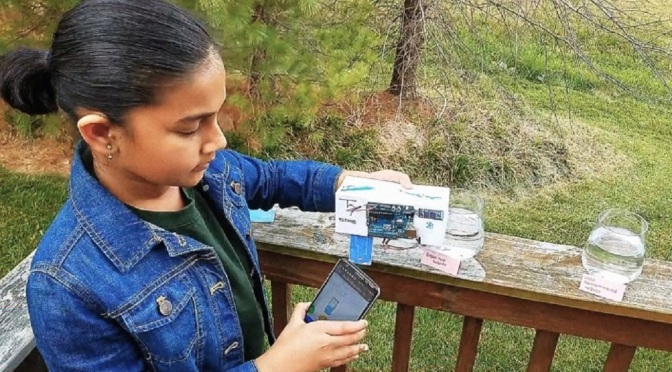Featured image: Rao demonstrating her prototype. Credit: Fast Company
Gitanjali Rao says “I believe that everyone has a right to know if their drinking water is safe or not.”
By Amelia Kinney, True Activist
11-year-old Gitanjali Rao had a vision of making water quality easier to detect. Her invention, the Tethys, uses carbon nanotube sensors to detect lead. The device connects to a mobile app to instantly report the water quality information.
“Before I had the idea for my solution, I noticed articles about how there was no solution to detect lead in water that is fast, easy, and inexpensive,” Rao told Fast Company in an interview. Rao recently graduated from 6th grade at Brentwood Middle School in Brentwood Tennessee. Her invention earned her finalist placing in the 2017 Discovery Education 3M Young Scientist Challenge.

“Using carbon nanotube sensors similar to those developed by MIT and others–tiny carbon tubes a few billionths of a meter in diameter–to detect lead in water. A small Arduino processor (a simple computer kit) connects to the nanotubes, and a Bluetooth attachment sends the results to a smartphone. Nearly instantly, you can know if your water is safe to drink,” reports Fast Company.
With Flint, Michigan being the latest victim of contaminated water, the myriad of devastating health effects from lead poisoning have been felt by thousands. Outdated infrastructure biggest challenge faced by cities when it comes to combatting lead contamination. Extensive pipe systems are expensive and time-consuming to replace.
Many places around the world would benefit from fast, accurate lead detection. A 2015 report estimated that 18 million people in the United States are currently using water systems with “unresolved lead violations”.
“I was appalled by the fact that there was no easy or effective solution. I did a little more research and I found out that Flint, Michigan wasn’t the only place with lead contamination. There were tons of places worldwide with water quality issues. I knew I wanted to solve this.”
Rao is currently working with a mentor at 3M to develop the invention for production. She hopes that one day it will retail for less than $20.00. The device is reusable, however the component that dips into the water would need to be replaced after each use.
“I really am interested in making it into a product that people can buy,” she says. “I believe that it would make the process so much easier, and I believe that everyone has a right to know if their drinking water is safe or not.”
What are your thoughts? Please comment below and share this news!


One thought on “11-Year-Old Invents Landmark Water Quality Detection Device”